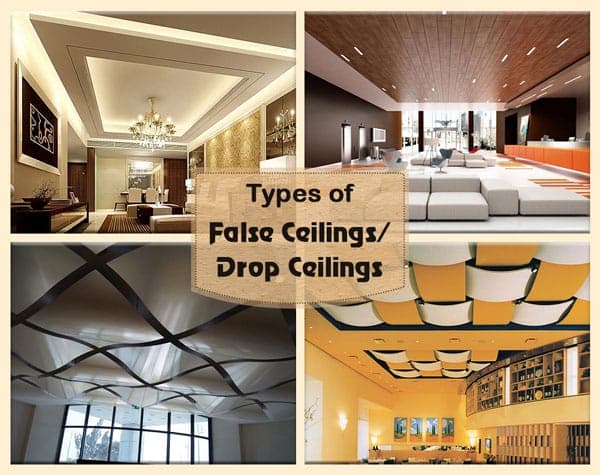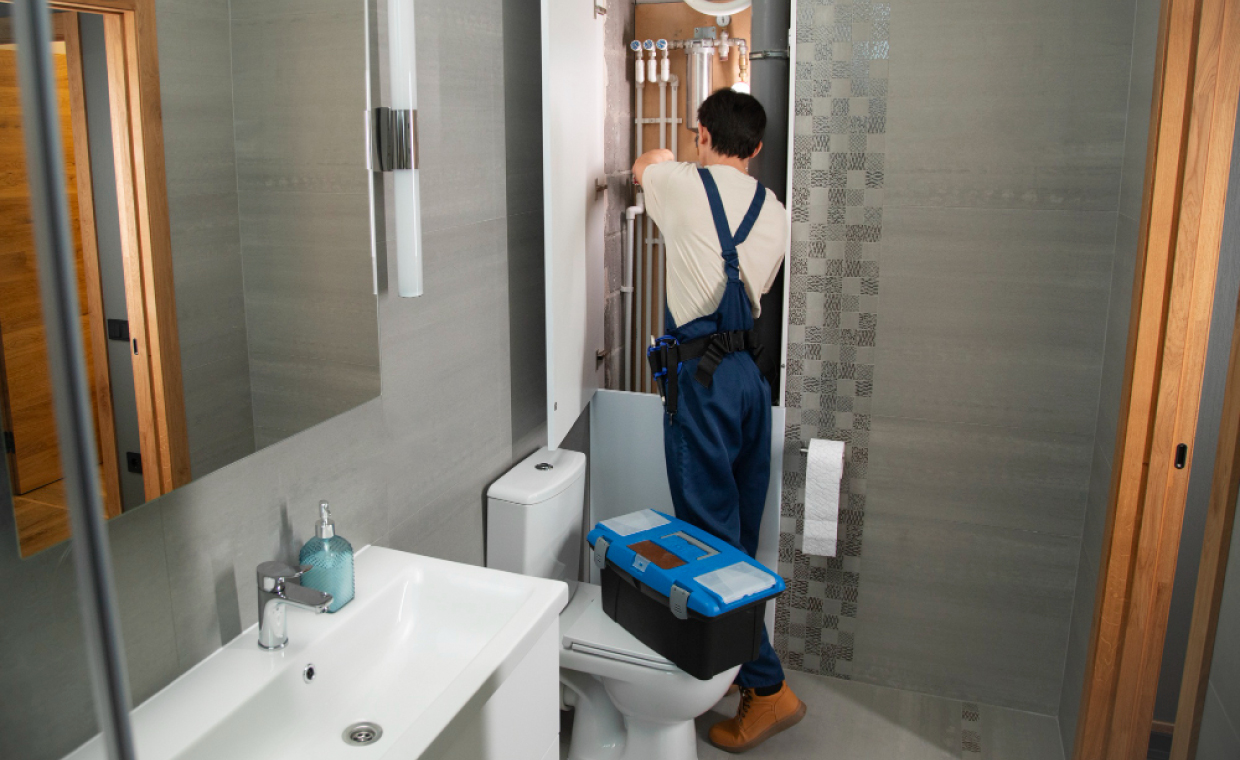
The trend of flat and simple ceilings is fading. Today, individuals are looking for products to make the mundane flat ceiling look appealing at a minimal cost. With the recent fall in the cost of false ceiling materials, the ceilings of commercial or residential spaces can be easily adorned.
False ceilings are often known as drop ceilings or suspended ceilings as they are literally dropped or hung from the main ceiling. Matthew Welch, the curator of Japanese and Korean Art Museum, Minneapolis Institute of Arts, said in an interview that dropped ceilings and ceiling tiles were first seen in Japan where they were employed for the aesthetic reasons during the Muromachi period (between 14th & 16th century).The different types of false ceilings seen in homes, offices, shopping complexes, restaurants, and theatres are generally the second ceiling hung below the main structural ceiling. The area above the false ceiling is called the plenum space, as it is sometimes used for the HVAC air return.
A room with a higher ceiling takes time to cool. In such cases, drop ceilings help cool the room by reducing the space for the air-conditioner. Covering the upper area with suspended ceilings has various other advantages. It conceals the air-conditioning ducts and wiring, the light frames and fixtures, security cameras, fire sprinklers and other fixtures. It adds beauty to the ceiling and provides a base for all kinds of decorative lights and fans. For homeowners looking to enhance both function and style, stretch ceiling installation London services offer a sleek, modern alternative that achieves all these benefits with a polished finish.
The false or drop ceiling is a good illustration of contemporary architecture in residential as well as commercial applications. Different spaces, lifestyle, and preferences demand the use of different types of false ceiling materials. Read on to know more about the various types of false ceilings designs and materials that can be used to boost your home decor.
Types of False Ceilings
There are numerous types of false ceiling used in home interiors. False ceilings can be differentiated in several ways according to their applications, materials utilized, appearance, and visibility. However, the most common classification is based on the materials used. Here are the 8 major types of false ceilings widely used.
- Acoustic Ceiling Panels or Rafts
- Plaster of Paris (POP) False Ceiling
- Wooden False Ceilings or Plywood False Ceilings
- Gypsum False Ceilings
- Metal False Ceilings
- PVC False Ceilings
- Fabric or Cloth False Ceilings
- Mineral Fibre False Ceilings
- Glass False Ceilings
Let’s get to know each of these types with their pros and cons.
01. Acoustic Ceiling Panels or Rafts

Acoustic ceiling panels or rafts, also known as sound-absorbing ceilings, are designed to reduce noise levels within a room by absorbing sound waves. Most popular in acoustic types such as ceiling baffles and ceiling rafts are specifically designed to improve sound quality within a space by absorbing or diffusing sound waves.
These ceilings are particularly beneficial in areas where noise reduction is critical, such as offices, conference rooms, studios, theatres, and educational institutions. Acoustic ceilings are typically made of materials such as fibreglass, mineral wool, or foam, which have excellent sound absorption properties.
Pros of Acoustic Ceilings:
- They effectively reduce noise levels, improving the sound quality of a room.
- Acoustic ceilings come in a variety of designs and styles such as ceiling baffles and rafts, allowing for customization to complement different interior aesthetics.
- Ceiling baffles can increase overall comfort and productivity in workplaces by creating a calming environment.
- They can be integrated with other roof features such as lighting fixtures and ventilation systems.
Cons of Acoustic Ceilings:
- Installation of acoustic ceilings can require professional expertise to ensure proper sound absorption and aesthetic appeal.
- Some acoustic roofing materials can be susceptible to moisture or moisture damage, which requires proper maintenance measures.
- Acoustic roofing materials and installation costs can be higher than standard roofing options.
02. Plaster of Paris (POP) False Ceilings

Plaster of Paris (POP) is the most commonly used false ceiling. Gypsum when heated softens, releases water, and forms POP! When water is added, POP hardens instantly. It is applied on fiberboard or a wood base, which is then suspended from the ceiling to form the false ceiling. The POP false ceiling looks attractive and has a long lifespan. They are excellent thermal insulators.
This kind of drop ceilings not only hides the hideous members of construction like the ventilation ducts and conduits but also gives a smooth finish to the ceiling.
Pros of POP False Ceilings:
- It gives a smooth, uniform finish. It is mouldable into any shape as per the design.
- The surface can be painted depending on your interior design.
- They are lightweight and durable.
- It is ideal for homes that require an indirect form of artificial light.
Cons of POP False Ceilings:
- The process of mixing the content of POP on-site is messy and tedious. Naturally, a lot of cleaning is needed after installing this type of suspended ceilings.
- A lot of POP mixture is wasted during the application process.
- The POP false ceiling has a higher risk of cracking in comparison to others.
Also Read: Plaster of Paris (POP) False Ceilings for Your Home Interior!
03. Wooden False Ceilings or Plywood False Ceilings

Some homeowners fancy natural and country-side beauty and serenity in their home interiors. The best way to achieve this rustic look is by using wooden beams on the ceilings. These wooden panels can be used to create several patterns that render a modern and attractive appeal to the ceiling. Wooden false ceilings also make a fine focal point for a room.
Owing to their natural textures and design, wooden false ceilings are being increasingly preferred by modern homeowners. These ceilings are also given different finishes to make them look more attractive.
Wooden false ceilings can be made either with hollow wooden blocks, wooden panels, wooden boards, or plywood. The wooden blocks can be easily installed using nails and screws. They are generally used in regions with cold weather conditions.
Pros of Wooden False Ceilings:
- They are strong and attractive.
- They can be given various finishes or painted to get the desired look.
- They can be easily treated to increase their lifespan.
Cons of Wooden False Ceilings:
- Wooden ceilings are difficult to maintain as they are prone to termite attacks.
- The room has to be thermally controlled to reduce the humidity in the air.
- Wood is also prone to warping and other physical changes that happen over time.
- Wooden false ceiling is costly; hence, one needs to consider the total false ceiling cost before going ahead. Wooden ceilings are less desirable for malls, hospitals, or large areas. However, they can be effectively installed in residential buildings and offices.
04. Gypsum False Ceilings

A gypsum false ceiling is made using gypsum boards, sheets, or ceiling tiles. Gypsum boards are larger than ceiling tiles. Gypsum false ceilings are tough, versatile, and economical. It is a sterile sulphate of calcium, light-weighted, and easy to install. Since gypsum is fire-resistant and soundproof, it is a preferred material for drop ceiling.
Generally, gypsum ceiling tiles are available in 600 mm × 600 mm. They are placed in the form of square planks with the support of the metal frame. The finishing of gypsum board ceilings can be done on the boards with paints, laminates, or wallpapers, thereby enhancing the appearance of the home interiors.
Pros of Gypsum False Ceilings:
Gypsum board is quite flexible. It allows various shapes & designs such as plain, stepped, curved, coffered, pelmet, drop design, etc.
- Glass fibre-reinforced gypsum board makes excellent insulation material.
- When exposed to fire, gypsum gives out water, which is converted to steam & helps to combat the fire. This makes the ceiling fireproof.
Cons of Gypsum False Ceilings:
- It cannot be used in rooms with damp conditions like the bathroom or laundry room.
- It cannot be moulded like POP ceilings.
- Recycling gypsum false ceiling is tough. Hence, it mostly ends up in landfills.
05. Metal False Ceilings

Metal is a durable home-decor material. Its lustre adds beauty and a sophisticated appeal to the interiors. Metal false ceilings are available in a form of ceiling tiles, planks, and panels. The most common metals used for drop ceilings are galvanized iron and aluminum.
Metal ceiling tiles of different sizes and thickness are available for the purpose of creating an internal false ceiling. The metal ceiling tiles or panels can be laid on a visible steel grid with T-sections or cross-sections that are suspended from the ceiling using rods. According to ‘Armstrong World Industries’ (AWI), the global leader in the design and manufacture of innovative commercial and residential ceiling, wall, and suspension system solutions, these tiles are available in many designs and have the ability to create a historic look with a contemporary touch! This makes metal ceilings an ideal choice when considering false ceiling designs for living room and other high-traffic areas.


Fixing and installation of the metal sheets is quite easy and consumes minimum labour. The hidden members of the structure are easily accessed as the metal ceiling tiles or panels can be easily removed and reattached. The construction cost is minimal as the installation, fixing, and maintenance of metal false ceilings is low.
Pros of Metal False Ceilings:
- They are ideal for workspaces which require clean environments and maintenance, such as the machinery rooms or Air Handling Units.
- Fire resistance is a huge advantage of metal false ceilings. This makes it ideal for homes and offices where fire safety is a concern.
- They do not crack or warp with time and retain their shape. So, peeling is unheard of. Metal ceilings need almost zero maintenance and repair.
Cons of Metal False Ceilings:
- Metal tiles do not have many cons, except for the cost of genuine metal materials. The investment can be substantial plus the cost of a protective coating to prevent corrosion over a time!
06. PVC False Ceilings

PVC ceilings are lightweight, moisture-resistant, and a perfect solution to prevent the dripping of water from the ceiling.
PVC ceiling tiles solve the problem of dirty and unhygienic ceilings as they are easy to clean and maintain. It is one of the few types of false ceiling that are easy to install, lightweight, waterproof, termite-proof, and need very little maintenance. Being non-porous and non-absorbent, they can incorporate flush-fitting ceiling lights, other types of lighting, access hatches, air vents, and sprinklers with ease. They are available in various colours and can be painted and polished too.
Pros of PVC False Ceilings:
- PVC ceilings are inexpensive to make and install.
- They are mass-produced and available through a wide variety of distributors. You can get almost any colour you desire.
- PVC false ceilings are durable and sturdy. They last for a very long time and need very little maintenance.
Cons of PVC False Ceilings:
- Though the chlorine in PVC makes these ceilings fire-resistant and durable, it is a dangerous and toxic gas in its natural state and a well-known carcinogen. Hence, excessive exposure to PVC can cause serious health issues.
- PVC is less attractive compared to other false ceiling materials.
07. Fabric or Cloth False Ceilings

Fabric is economical and can be draped across the ceilings for temporary purposes in places such as churches, yoga rooms, restaurants, ballrooms, and function halls. They are not highly recommended as they collect dust over a period of time. The light diffused through fabrics provides a comfortable intensity and renders a warm mood to the room. This kind of false ceiling is not as functional as others but definitely elevates the look of a room.
Pros of Fabric False Ceilings:
- Installation is quick, easy, and does not require a highly skilled professional.
- Very few types of false ceilings can match the aesthetic value added by high-quality fabric.
Cons of Fabric False Ceilings:
- Cloth accumulates dust and stains easily. It also absorbs odours.
- It cannot be used as a permanent home decor feature.
08. Mineral Fibre False Ceilings

Mineral fibre ceiling tiles are developed by natural or synthetic minerals. This type of drop ceiling uses mineral tiles that are ceramics, reinforced with natural stone, wood, vegetable fibre, bitumen, and tars. These elements increase the insulation capacity of the product. Therefore, they are perfect for areas where heat and sound insulation is needed. Mineral fibre ceiling tiles are available in a variety of sizes, shapes, and patterns. They are economical and quick to install!
Pros of Mineral Fiber False Ceilings:
- They have high insulation against sound and fire.
- The fibre element in these tiles increases the hardness and toughness of the material.
Cons of Mineral Fiber False Ceilings:
- Cannot be used for residential areas as they are appealing for home interior.
- They are highly susceptible to water damage.
09. Glass False Ceilings

Glass is a non-crystalline, brittle, and transparent material. Because of its transparency, it makes a living or working space look bigger and grand. Therefore, it can be used for the false ceiling of places such as restaurants and libraries. Glass is a good heat insulator too.
Glass can be made non-brittle and opaque using certain admixtures or processes. This not only makes glass false ceilings safe but also tackles the issue of lack of privacy.
Pros of Glass False Ceilings:
- It allows the eyes to travel and explore the space without obstruction.
- Glass can be coloured, patterned, or laminated to create an interesting focal point for a room.
Cons of Glass False Ceilings:
- The glass ceiling panels need to be handled with care during the installation process.
- Glass is one of the most expensive false ceiling materials available.
- Dust and dirt easily show on glass. Hence, it needs to be cleaned on a regular basis.
- Its fixing requires special skills and specific fixtures.
In a nutshell, false ceiling increases the aesthetic appeal of the home interiors, hides all the ugly elements and fixtures, and imparts a smooth finish to the ceiling. No wonder, most malls, hospitals, theatres, offices, and residential buildings are employing innovative false ceiling materials to improve the attractive appeal of their spaces.
Many homeowners and businesses are using two or more types of false ceiling materials too. For instance, the combination of wood and POP is quite common these days. You can also go for many other combinations too!
Also Read:
9 Secrets of Perfect Interiors for Your Home!
WPC Board (Wood Plastic Composite) – Things You Need To know!!!
Plywood Buying Guide: Choose the Good Quality Plywood
You may love to see few enormous contemporary and modern false ceilings designs of the designers:



Image Courtesy: Image 2, Image 3, Image 4, Image 5, Image 6, Image 9, Image 10






























